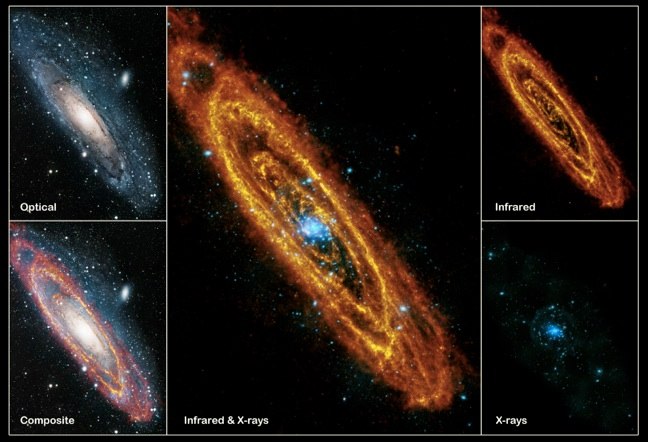Herschel



With its 3.5-meter (11.5 ft) mirror, Herschel is the largest IR telescope ever launched, and it was sensitive to light in the Far-Infrared and Sub-millimeter domain, approximately from 55 to 670 µm.
I am involved, at different levels, in a number of projects using Herschel observations. For many of these, I was responsible for the reduction and quality assess of PACS data.
DUSTPEDIA:
A definitive study of the cosmic dust
DUSTPEDIA is an international project born from the ashes of the HeViCS collaboration, whose main goal is the homogeneous analysis of Herschel and Planck data of a sample all the most nearby galaxies observed by the two satellites (with the exception of the largest ones: the Magellanic clouds, M31, and M33).
The sample, containing almost 1000 galaxies, is complemented with literature ancillary data at all wavelengths.
Please have a look at the official webpage for more info about the project, its products, and the teams actively involved.
The following is the list of papers so far accepted:
“DustPedia: Multiwavelength Photometry and Imagery of 875 Nearby Galaxies in 42 Ultraviolet-Microwave Bands”, C. J. R. Clark, S. Verstocken, J. Fritz, S. Bianchi, S. Viaene, M. W. L. Smith et al. 2018, A&A, 609, 37
“DustPedia - A Definite Study of Cosmic Dust in the Local Universe” Davies J., Baes M., Bianchi S., Jones A., Madden S., Xilouris M., Bocchio M., Casasola V., Cassara L., Clark C., De Looze I., Evans R., Fritz J., Galliano F., Lianou S., Mosenkov A.V., Smith M., Verstocken S., Viaene S., Vika M., Wagle G., Ysard N., 2017, PASP, 129, 4102
“Radial distribution of dust, stars, gas, and star-formation rate in DustPedia face-on galaxies”. V. Casasola, L. P. Cassarà, S. Bianchi, S. Verstocken, E. Xilouris, L. Magrini, M. W. L. Smith, I. De Looze, M. Galametz, S. C. Madden, M. Baes, C. Clark, J. Davies, P. De Vis, J. Fritz, F. Galliano, A. P. Jones, A. V. Mosenkov, S. Viaene, N. Ysard 2017, A&A, 605, 18
OTHER PROJECTS INVOLVING HERSCHEL OBSERVATIONS
HeViCS - Observations of the Virgo cluster
(P.I.: J. Davies)
HeFoCS - Observations of the Fornax cluster
(P.I.: J. Davies)
H-ATLAS - Shallow observations of 600☐
(P.I.: S. Eales)
HELGA - Observations of M31
(P.I.: J. Fritz)
SAFIR - Observations of nearby AGNs,
(P.I.: M. Sanchez-Portal)
HEROES - Observations of Edge-on Spirals (P.I.: M. Baes)
FRIEDL - Observations of Dust lane ellipticals (P.I.: M. Baes)
PACS HRS - Completion of the HRS survey (P.I.: L. Cortese)
PACS observations of M87
(P.I.: J. Fritz)
(P.I.: J. Davies)

I was the P.I. of Herschel large-field observations of M31 (HELGA: the Herschel Exploitation of the Local Galaxy Andromeda), that was under the spotlight thanks to the BBC show Stargazing in January 2011, just a couple of weeks after the observations were performed. You can have a look at it on YouTube:
And here’s the beautiful image ESA made combining our infrared observations (SPIRE 250 micron; credits for the data reduction go to Matthew Smith of the School of Physics and Astronomy - Cardiff) with optical and X-ray:

Check out last paper of the HELGA, series, HELGA VII, by Sebastiene Viaene. It is an incredibly accurate radiative transfer model of the full galaxy, something never attempted before, to study in detail the dust heating mechanisms, with a focus on the properties of the stellar populations influencing the dust temperature, as a function of the position in the galaxy.
